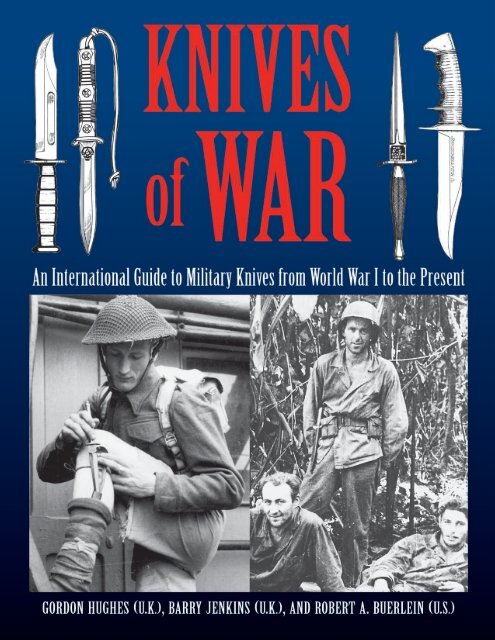Knives of War: An International Guide to Military ... - Paladin Press
Knives of War: An International Guide to Military ... - Paladin Press
Knives of War: An International Guide to Military ... - Paladin Press
Create successful ePaper yourself
Turn your PDF publications into a flip-book with our unique Google optimized e-Paper software.
CONTENTS<br />
Introduction - - - - - - - - - - - - - - - - - - - - - - - - - - - - - - - - - - - - - - - - - - - - - - - - - - - - - - - - - - - - - - - - 1<br />
Chapter 1: Fairbairn-Sykes Fighting <strong>Knives</strong>, Variants, and Stilet<strong>to</strong>s - - - - - - - - - - - - - - - - - - - - - - - - - 5<br />
Chapter 2: <strong>Knives</strong> <strong>of</strong> the Allies <strong>of</strong> World <strong>War</strong>s I and II - - - - - - - - - - - - - - - - - - - - - - - - - - - - - - - - - - 21<br />
Chapter 3: Germany’s Trench <strong>Knives</strong> and Those <strong>of</strong> Its Central and Axis Power Allies - - - - - - - - - - - - 35<br />
Chapter 4: Knuckle <strong>Knives</strong> - - - - - - - - - - - - - - - - - - - - - - - - - - - - - - - - - - - - - - - - - - - - - - - - - - - - - 45<br />
Chapter 5: The Big <strong>Knives</strong> - - - - - - - - - - - - - - - - - - - - - - - - - - - - - - - - - - - - - - - - - - - - - - - - - - - - - - 59<br />
Chapter 6: Bayonet, Sword, and Other Conversions - - - - - - - - - - - - - - - - - - - - - - - - - - - - - - - - - - - - 75<br />
Chapter 7: Ceremonial Hangers - - - - - - - - - - - - - - - - - - - - - - - - - - - - - - - - - - - - - - - - - - - - - - - - - - 83<br />
Chapter 8: Folding and Gravity <strong>Military</strong> <strong>Knives</strong> - - - - - - - - - - - - - - - - - - - - - - - - - - - - - - - - - - - - - - - 89<br />
Chapter 9: Trench Clubs - - - - - - - - - - - - - - - - - - - - - - - - - - - - - - - - - - - - - - - - - - - - - - - - - - - - - - - 95<br />
Chapter 10: Contemporary <strong>Knives</strong> Since World <strong>War</strong> II - - - - - - - - - - - - - - - - - - - - - - - - - - - - - - - - - - 101<br />
Chapter 11: Miscellaneous - - - - - - - - - - - - - - - - - - - - - - - - - - - - - - - - - - - - - - - - - - - - - - - - - - - - - - 111<br />
v
CHAPTER 3<br />
GERMANY’S TRENCH KNIVES AND THOSE OF ITS<br />
CENTRAL AND AXIS POWER ALLIES<br />
The German trench knife <strong>of</strong> the 1914–1918 conflict was well<br />
remembered by the sons who <strong>to</strong>ok a very similar design with<br />
them <strong>to</strong> war from 1939–1945. This chapter includes<br />
examples <strong>of</strong> both.<br />
The smaller sheath knives are <strong>of</strong>ten referred <strong>to</strong> as “jackboot<br />
knives” or “boot knives,” as many had a spring steel clip that could be<br />
affixed <strong>to</strong> the upper edge <strong>of</strong> the boot when the sheath was worn inside<br />
the side <strong>of</strong> the boot. A knife <strong>of</strong> this type was also called a<br />
Nahkampfmesser (close-combat knife).<br />
In Germany, the tradition <strong>of</strong> hunting is very well ordered and<br />
structured, so it is not surprising <strong>to</strong> find staghorn grips, traditional on<br />
the important German ceremonial hunting (jäger) knives and short<br />
swords, on certain German military edged weapons—especially on<br />
finer presentation pieces and, particularly, on private-purchase knives.<br />
Homer Brett reports, “In 1916 <strong>of</strong>ficers and NCOs were <strong>of</strong>ficially<br />
ordered not <strong>to</strong> wear swords in the field, and quite rapidly bayonets<br />
and trench knives <strong>to</strong>ok their place as signs <strong>of</strong> rank and position,”<br />
although most <strong>of</strong> these could have been more elaborate than those<br />
shown in this chapter.<br />
35
36<br />
KNIVES OF WAR<br />
3-1<br />
3-1A<br />
3-2<br />
3-2A<br />
Figure 3-1. A good-quality hunting knife <strong>of</strong> World <strong>War</strong> I vintage destined for sale <strong>to</strong><br />
military personnel, as is evident from the etching on the blade <strong>of</strong> a German soldier with his<br />
rifle advancing through trees. The knife was made by <strong>An</strong><strong>to</strong>n Wingen, Jr., Solingen. The<br />
bright blade is double-edged, and the grip is staghorn. The steel scabbard is painted black.<br />
Blade length, 5 inches; overall length, 10 1/4 inches.<br />
Figure 3-2. <strong>An</strong>other variation <strong>of</strong> the German World <strong>War</strong> I “hunting knife” type <strong>of</strong><br />
trench knife with staghorn grip. The steel crossguard is integral with the blade, as on Figure<br />
3-12. The blade <strong>of</strong> this knife is <strong>of</strong> above-average quality and is marked as illustrated. The<br />
upper cutting edge extends three-quarters <strong>of</strong> the way along the <strong>to</strong>p <strong>of</strong> the blade, making it<br />
virtually double-edged. Sometimes these stag-hilted knives are found with commemorative<br />
etchings showing the crossed flags <strong>of</strong> Germany, the Austro-Hungarian Empire, and Turkey<br />
(with the colors <strong>of</strong> the flags being in enamel) and the words “IM STURME TREU” (Faithful in<br />
Battle). Blade length, 5 inches; overall length, 10 inches.<br />
Figure 3-3. This is a typical example <strong>of</strong> a privately purchased hunting-type knife that<br />
was much favored for trench use. There are many variations <strong>of</strong> this type, but, generally<br />
speaking, the grip was <strong>of</strong> staghorn (or occasionally <strong>of</strong> steel simulating the appearance <strong>of</strong><br />
staghorn), the mounts are German silver, and the sheath (Figure 3-3A) is leather with a<br />
metal tip. The blade shapes varied (see Figure 3-2); some were double-edged (as in the<br />
illustration) while others had only one cutting edge. They are normally <strong>of</strong> good quality, and<br />
the only marking, if any, is a manufacturer’s name or trademark, such as “D. PERES,<br />
SOLINGEN,” “ED. WUSTHOF, SOLINGEN,” or “J.H. BECKER <strong>of</strong> SOLINGEN.”<br />
3-3<br />
3-3A
GERMANY’S TRENCH KNIVES AND THOSE OF ITS CENTRAL AND AXIS POWER ALLIES 37<br />
3-4<br />
3-4A<br />
3-5<br />
3-6<br />
3-7<br />
Figure 3-4. A small World <strong>War</strong> I–period hunting knife as<br />
carried by many German soldiers at the front. It has staghorn<br />
grips and a small steel crossguard integral with the blade. The<br />
sheath is brown leather. Blade length, 4 1/8 inches; overall<br />
length, 8 7/8 inches.<br />
Figure 3-5. <strong>An</strong>other German trench knife with staghorn<br />
grips and blade. It is unusual in that the blade appears <strong>to</strong> be<br />
reversed (as with some bayonets), as the main cutting edge<br />
wants <strong>to</strong> be on the lower edge <strong>of</strong> the blade. The scabbard is <strong>of</strong><br />
black-painted steel.<br />
Figure 3-6. German World <strong>War</strong> I trench knife by Hugo<br />
Koller, Solingen, with a somewhat unusually shaped wooden<br />
grip and crossguard. Blade length, 5 5/8 inches; overall length,<br />
10 1/2 inches.<br />
Figure 3-7. German World <strong>War</strong> I trench knife by Hugo<br />
Koller, Solingen, with wood grips and double-edged blade.<br />
Blade length, 5 7/8 inches; overall length, 10 3/4 inches.
38<br />
KNIVES OF WAR<br />
3-8<br />
3-8A<br />
3-9<br />
3-10<br />
Figure 3-8. The standard trench/combat knife <strong>of</strong> the<br />
Austro-Hungarian armies during World <strong>War</strong> I, a sturdy, wellmade<br />
knife suitable for heavy-duty utility use as well as for<br />
hand-<strong>to</strong>-hand combat. The blade, more than 1 inch wide at the<br />
forte, is single-edged, with a false edge as shown in the<br />
illustration. The hilt is wood, <strong>of</strong> round section, with a heavy,<br />
quality oval steel guard, generally stamped either with the<br />
Austrian eagle or the Hungarian coat <strong>of</strong> arms. The blade is<br />
usually unmarked except for some letters, as shown, although<br />
the example illustrated does have a manufacturer’s name, which<br />
appears <strong>to</strong> be Czech. The scabbards are steel, with a leather or<br />
canvas belt loop and are <strong>of</strong>ten marked with the letters V. & N.<br />
for the Hungarian firm <strong>of</strong> Vogel & Noot. Italian troops captured<br />
and used a number <strong>of</strong> these knives later in the war. Blade length,<br />
8 1/2 inches; overall length, 13 1/4 inches.<br />
Figure 3-9. A scarce all-steel trench knife <strong>of</strong> superior<br />
quality. The conventional blade shape is unmarked except for a<br />
type <strong>of</strong> patent mark, “GES. GESCH.” (Gesetzlich Geschutz,<br />
[patented by law]), stamped on the heavy, steel-grip bolster, as<br />
shown. Blade length, 5 7/8 inches; overall length, 10 1/2 inches.<br />
Figure 3-10. Uncommon World <strong>War</strong> I trench knife. The<br />
blade is single-edged, the back being beveled for most <strong>of</strong> its<br />
length. The grips are wooden and <strong>of</strong> conventional design, but<br />
the crossguard is integral with the blade and tang. The<br />
inscription on the blade means “1914–1915 Campaign.” Blade<br />
length, 5 7/8 inches; overall length, 10 3/4 inches.
GERMANY’S TRENCH KNIVES AND THOSE OF ITS CENTRAL AND AXIS POWER ALLIES 39<br />
3-11<br />
3-12<br />
3-13<br />
Figures 3-11 through 3-13. These are three variations <strong>of</strong><br />
German World <strong>War</strong> II close-combat knives. These are <strong>of</strong>ten<br />
known as “jackboot knives,” as the sheaths had a spring clip<br />
(instead <strong>of</strong> the World <strong>War</strong> I belt loop) for affixing the knife <strong>to</strong><br />
the side <strong>of</strong> the boot or sometimes <strong>to</strong> the lapel <strong>of</strong> the greatcoat.<br />
Figure 3-12. This knife has a similar hilt, but the<br />
crossguard is s<strong>to</strong>uter and the blade single-edged. Blade length,<br />
5 3/4 inches; overall length, 10 1/4 inches.<br />
Figure 3-13. This is also a single-edged blade, marked<br />
“PUMA, SOLINGEN,” but the grips are <strong>of</strong> a reddish plastic,<br />
similar <strong>to</strong> the World <strong>War</strong> II M84/98 bayonet. Blade length, 5 3/4<br />
inches; overall length, 10 inches.<br />
3-14<br />
3-14A<br />
Figure 3-14. Stag-hilted, Bowie-bladed knife/bayonet. This bayonet would affix <strong>to</strong> the Mauser K98 rifle but is obviously not a<br />
military-issue weapon. It may have been specially made for a hunter who used such a rifle <strong>to</strong> double as a good, heavy hunting knife<br />
and <strong>to</strong> be affixed on the rifle as a last-ditch defense weapon. Or it could have been made as a special military presentation piece. There<br />
are no markings, but the whole piece is <strong>of</strong> high quality. The pommel and crossguard are painted black, and the sheath is brown leather.<br />
The blade length is approximately 8 inches.
40<br />
KNIVES OF WAR<br />
3-15<br />
3-16<br />
3-17<br />
Figure 3-15. A rare combination trench knife/bayonet <strong>of</strong><br />
all-steel construction (compare <strong>to</strong> Figure 3-17). This has the<br />
standard 5 1/2-inch trench knife blade and a pressed-steel hilt,<br />
painted field green, which could be attached <strong>to</strong> the rifle for use<br />
as a bayonet. The blade is stamped with two s<strong>to</strong>rks at the forte,<br />
the trademark <strong>of</strong> Robert Klass, Solingen. Blade length, 5 1/2<br />
inches; overall length, 10 1/2 inches.<br />
Figure 3-16. This trench knife/bayonet has a hilt similar <strong>to</strong><br />
the one in Figure 3-23, but an unusual Bowie-type blade just<br />
over 6 inches long bearing the early W.K.C. trademark. It is a<br />
well-made, high-quality weapon. It has also been noted with<br />
staghorn grips. Overall length, 11 inches.<br />
Figure 3-17. The better-known though still scarce all-steel<br />
trench knife/bayonet, generally known as the “DEMAG”<br />
(Deutsche Maschine-Fabrik A.G. [German Engineering Works<br />
Ltd.]) from the trademark on the blade. The other letters<br />
commonly found on this and other unusual models <strong>of</strong> bayonet<br />
and knife are “D.R.G.M.,” which stands for Deutsches Reichs Ge-<br />
Brauchsmuster (German Empire utility design). Unlike Figure 3-<br />
15, this knife has a double-edged blade 5 7/8 inches long, an<br />
all-steel “cranked” hilt, and small steel crossguard with a small<br />
hole in the upper part. The hilt was painted olive green. It is<br />
thought that these items were privately purchased, though one<br />
has reportedly been seen with the Imperial German inspection<br />
mark. Overall length, 10 1/4 inches.<br />
NOTE: Some wooden-gripped trench knives (not<br />
bayonets) made by DEMAG used parts from this bayonet/knife,<br />
namely the unusual crossguard with either the double-edged<br />
blade or the standard blade (Figure 3-15).
GERMANY’S TRENCH KNIVES AND THOSE OF ITS CENTRAL AND AXIS POWER ALLIES 41<br />
Figures 3-18 through 3-22. These are all variations <strong>of</strong><br />
the wooden-gripped trench/combat knives, many <strong>of</strong> which<br />
were standard-issue items and bear the Imperial German<br />
inspection mark either at the forte or on the back edge <strong>of</strong> the<br />
blade. In all cases the sheath is the same as Figure 3-19A:<br />
black-painted steel, with leather belt loop and retaining strap.<br />
They are by various makers, as shown in the illustrations.<br />
Figure 3-19. This is interesting as it comes with either<br />
the wooden grip, as illustrated, or the rarer all-steel grip,<br />
which has the same shape and grooves as the wooden-grip<br />
version.<br />
Figures 3-21 and 3-22. The “RASIERMESSER FABRIK”<br />
(razor fac<strong>to</strong>ry) inscription on Figure 3-21 illustrates how<br />
German civilian firms were used <strong>to</strong> produce military equipment<br />
during the war (as were those in other countries. Figure 3-22<br />
has a commemorative inscription: “Christmas 1916, 2nd<br />
Batallion Infantry Regiment 417.” Without the inscription, this<br />
pattern knife is the most common pattern <strong>to</strong> be found and is<br />
lighter in construction than the others. This pattern also exists<br />
with a sawback consisting <strong>of</strong> 13 rows <strong>of</strong> saw teeth and<br />
staghorn grips secured by three rivets. Examples are also noted<br />
with checkered black metal grips.<br />
Figure 3-20. This has been seen with deeply engraved S.S.<br />
runes on one side <strong>of</strong> the blade and “FINGERSPITZENGERFÜHL”<br />
(fingertip feel) on the other.<br />
3-18<br />
3-19A<br />
3-19<br />
3-20 3-21 3-22
42<br />
KNIVES OF WAR<br />
3-23<br />
3-24<br />
3-25<br />
3-26<br />
Figure 3-23. This has the standard trench knife blade, but<br />
with a hilt similar <strong>to</strong> the dress bayonets <strong>of</strong> World <strong>War</strong> II. Some<br />
examples <strong>of</strong> this pattern knife could actually be affixed <strong>to</strong> the<br />
rifle; others merely had dummy catch but<strong>to</strong>ns.<br />
Figure 3-24. A folding-lock blade popular with German<br />
troops in the trenches. This useful all-purpose knife could be<br />
carried in a pocket and yet, with the blade locked in the open<br />
position, made an effective combat weapon. The example<br />
illustrated has “NAHKÄMPFER” (close fighter) on the reverse <strong>of</strong><br />
the forte. <strong>An</strong>other example has the trade name<br />
“MERCATOR/D.R.G.M.” at the forte and along the back <strong>of</strong> the<br />
grip. This also has a slightly different locking catch. Blade<br />
length, 4 inches; overall length, 9 inches.<br />
Figure 3-25. A good-quality German World <strong>War</strong> II<br />
knife/sidearm. <strong>An</strong> ex-Luftwaffe member has confirmed that<br />
this type <strong>of</strong> knife was issued <strong>to</strong> him when he was serving at<br />
the seaplane base in Tromso, northern Norway, in 1944–45. It<br />
is a very high-quality knife with the so-called carbine blade <strong>of</strong><br />
the walking-out bayonets <strong>of</strong> the German army (its scabbard is<br />
the same as those). The grips are real staghorn secured by<br />
three screwbolts. <strong>An</strong>other specimen has been seen with<br />
blackened staghorn grips. Blade length, 8 inches; overall<br />
length, 12 5/8 inches.<br />
Figure 3-26. German World <strong>War</strong> II trench knife by Puma,<br />
Solingen, with dark red plastic grips. However, this example has<br />
the more common clip-point trench knife blade. The scabbard<br />
is the standard jackboot knife type with a clip <strong>to</strong> attach <strong>to</strong> a<br />
boot or other equipment. Blade length, 5 3/4 inches; overall<br />
length, 10 inches.
GERMANY’S TRENCH KNIVES AND THOSE OF ITS CENTRAL AND AXIS POWER ALLIES 43<br />
3-27<br />
3-28<br />
3-29<br />
3-28A 3-29A<br />
Figure 3-27. Finnish SK organization knife (<strong>of</strong>ficial “protection groups”) based<br />
on the traditional Finnish hunting knife, the puukko. The grip is <strong>of</strong> light birch wood,<br />
and the blade is marked “Hackman and Co.” The sheath is brown leather with a blue<br />
and gray dress knot. Elite Finnish SK troops used these knives in their Winter <strong>War</strong><br />
against the Soviets. The blades are <strong>of</strong> laminated steel. Overall length, 11 1/8 inches.<br />
Figure 3-28. Knife carried by the Finnish army, SK organization, and police.<br />
Both Finnish and German manufacturers made these knives. All metal parts are<br />
chromed, with black grips and scabbards. Overall length, 10 1/4 inches.<br />
3-27A<br />
Figure 3-29. This knife, with a longer blade, was also carried by the Finnish<br />
army, SK organization, and police. Both Finnish and German manufacturers made<br />
these knives. All metal parts are chromed, with black grips and scabbards. Overall<br />
length, 11 7/8 inches.
44<br />
KNIVES OF WAR<br />
3-30<br />
3-30A<br />
3-31<br />
3-31A<br />
3-32<br />
3-32A<br />
Figure 3-30. A double-edged, stilet<strong>to</strong>-type knife <strong>of</strong> Finnish<br />
origin by Hackman & Co.<br />
Figure 3-31. This sturdy Italian combat knife is<br />
reminiscent <strong>of</strong> the World <strong>War</strong> I Austro-Hungarian knife. It is not<br />
known <strong>to</strong> which units this knife was issued, but a pho<strong>to</strong>graph<br />
exists that clearly shows the knife being worn by a member <strong>of</strong><br />
the Italian S.S. (Legione S.S. Italiana). Three rivets secure the<br />
wraparound wooden grips, and the crossguard is a heavy oval<br />
steel disc. There are no markings on either the knife or the<br />
black-painted steel scabbard. The steel belt loop has a swivel<br />
bar <strong>to</strong> enable the sheath <strong>to</strong> be removed easily. Blade length, 8<br />
1/4 inches; overall length, 13 inches.<br />
Figure 3-32. A short version <strong>of</strong> Figure 3-31 carried by<br />
Italian frogmen in World <strong>War</strong> II. The two metal loops on the<br />
scabbard were for arm or leg straps—alternatively, this knife<br />
could be carried inverted, suspended from a “dog lead” type<br />
spring clip. Blade length, 4 1 /8 inches; overall length, 8 7/8<br />
inches. NOTE: The Italian frogmen <strong>of</strong> MASX were legendary<br />
against the British and were in many ways forerunners <strong>of</strong> the<br />
U.S. Navy SEAL teams.

















